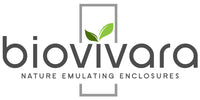5 Critical Questions to Ask Before Buying Your Next Enclosure - Part 2: Is It Safe?
Last week we looked at what to look for in order to simulate a natural environment in your enclosure. This week, we look at safety.
QUESTION #2: IS IT SAFE?
It isn’t enough for an enclosure to be able to reproduce the natural conditions for your plants and animals to thrive. An enclosure must also reproduce these conditions safely.
Here's how:
Safely Sequester Mechanical Components
While mechanical components like fans and pumps are important for your habitat’s ongoing health, it is also really important to separate them from the actual environment.
Fans
Fans should never dangle in an enclosure where the blades could come in contact with plants or animals. Instead, a fan should be mounted in an enclosed vent, preferably also hidden from human view or placed in an inconspicuous way so it doesn’t detract from the overall visual enjoyment of the enclosure.

Above: An example of our Air Cycling System. The fan, mounted in a separate chamber at the top of the enclosure, pulls air from the back of the enclosure and pushes it out the front over the doors, which also helps keep the front viewing area clear of condensation in high humidity environments.
Pumps
Pumps, likewise, should be both hidden from view and from pet access. Two good ways to incorporate a pump into an enclosure design are:
1. Create a separate compartment within the enclosure for the pump to sit.

Other Safety Features
- Can the doors or access panels be secured with a lock? This is especially important when the enclosure is in a high traffic area, such as a living room, or if children will have access to it.
- How likely is it to break? If you want an enclosure to display in your home or office, you want to be reasonably sure it won't break. Because it is 17 times stronger than glass and less likely to shatter if impacted, acrylic is often used in zoos and other public displays. With advancements in acrylic enclosure design, you now have access to acrylic enclosures that perform well over time, are scratch-resistant, and are safer than glass.
